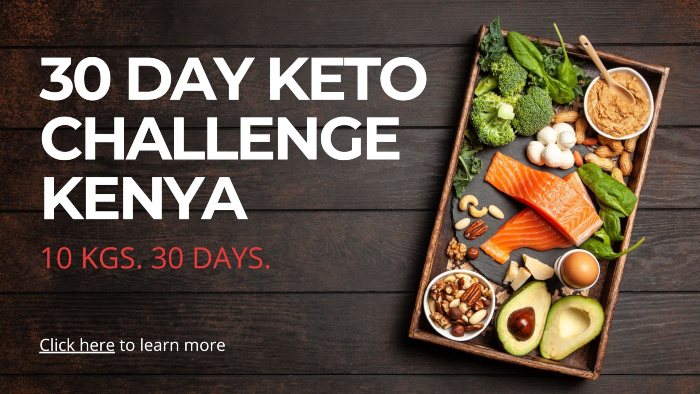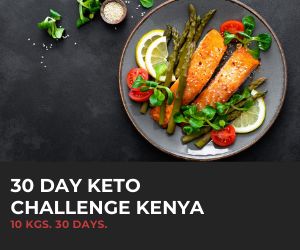What is the Keto Diet
Keto is a low-carb, high-fat diet that involves reducing your carbohydrate consumption drastically and replacing it with healthy fats.
This carb reduction puts your body in a metabolic state called ketosis, where it burns fat for fuel instead of glucose.
Studies have shown that ketosis helps boost energy and mental clarity, and is very effective for weight loss.
It usually takes about 5 days after starting the keto diet to get into ketosis, and a few weeks before your body fully adopts to burning fat for fuel. Some signs that you’re in ketosis include increased energy, concentration and decreased appetite.
Before deciding whether keto is for you, sign up for the 30 Day Keto Challenge Kenya to get a first-hand idea of what the diet is like, and whether it will be sustainable long term.
The 30 day challenge comes with guided instructions that makes it very easy for people who are new to low carb dieting. You will also get a meal planning guide to help with your food and ingredient selections (based on the Kenyan diet).
Types of Keto Diets
Standard Keto Diet (SKD): This is a low carb, moderate protein, high-fat diet. It generally consists of 75% fat, 20% protein, and 5% carbohydrates.
Cyclical Keto Diet (CKD): Cyclical keto involves periods of eating low carbs followed by periods of eating high carbs to refill the muscles. For example, five on low carbs followed by two high carb days.
Targeted Ketogenic Diet (TKD): Targeted keto allows you to consume carbs before your workouts.
Benefits of the Keto Diet
- Weight loss and maintenance: Numerous studies have shown that keto helps achieve rapid weight loss.
- Blood sugar control: The absence of carbs helps reduce spikes in blood sugar levels.
- Insulin sensitivity: Keto has been shown to help restore insulin sensitivity by eliminating the leading cause of insulin resistance. Low carbs mean lower insulin levels.
- High blood pressure control: Many people live with high blood pressure in Kenya. The keto diet can help lower blood pressure levels in people who are overweight or have type 2 diabetes.
- Enhanced cognitive performance: Keto helps improve memory, mental clarity and one’s ability to focus. Increasing your intake of healthy omega-3 fats (such as those found in fatty fish) can improve your mood and ability to learn. Omega-3 increases a fatty acid called DHA, which makes up 15 to 30 per cent of our brain.
- Controlled appetite and cravings: Reduced appetite and cravings are common signs that the body is in ketosis.
Keto Diet Foods Kenya
Fish and seafood
Most fish and shellfish are keto friendly. Fish is a great source of B vitamins, potassium, and selenium, and is practically free of carbohydrates.
Low carb keto sea food:
- Tilapia
- Catfish
- Mackerel
- Red and white snapper
- Nile perch
- Herring
- Omena
- Tuna
- Crab
- Shrimp
- Prawn
Meat and poultry
Most meats and poultry do not contain carbs and are rich in B vitamins and several essential minerals.
Meat is a great source of high-quality protein, which helps preserve muscle mass when on a low-carb diet.
Low carb keto meats and poultry:
- Beef
- Chicken
- Goat
- Turkey
- Duck
- Sheep
- Pork
- Eggs
- Bacon
Low carb vegetables
Many non-starchy vegetables are low in carbohydrates but high in vitamin C and various other minerals.
In addition to that, cruciferous vegetables like kale, broccoli, and cauliflower have been linked to a lower risk of cancer and heart disease.
In keto, low-carb vegetables are usually the substitutes for high-carb foods. For example, cauliflower can be used in place of rice or mashed potatoes.
Below are some examples of keto-friendly veggies to include in your diet plan.
Low carb keto vegetables:
- Cabbage
- Kale (or Sukuma wiki)
- Spinach
- Managu
- Kunde
- Asparagus
- Avocado
- Cauliflower
- Broccoli
- Cucumber
- Green Beans
- Eggplant
- Lettuce
- Olives
- Peppers (mostly green)
- Tomatoes
- Zucchini
- Mushroom
- Onion
Nuts and Seeds
Nuts and seeds are generally keto friendly – high in fat and moderate in carbohydrates.
Low carb keto nuts and seeds:
- Almonds
- Cashews
- Macadamia nuts
- pistachios
- Chia seeds
- Flaxseed
- Pumpkin seeds
- sesame seeds
Fruits and Berries
Most fruits are unfortunately too high in sugar and carbs to include on a ketogenic diet.
Berries are low in carbohydrates and high in fiber. They are also high in antioxidants that have been credited with reducing inflammation and protecting against disease.
Low carb keto fruits and berries:
- Blackberries
- Blueberries
- Raspberries
- Strawberries
- Lemon
- Peach
- Watermelon
- Avocado
- Olives
Drinks
Coffee is a great keto supplement as it contains high levels of caffeine, which when combined with ketosis, helps stimulate the metabolism even further – helping improve both physical and cognitive performances, alertness, and mood.
The only catch is that you have to avoid sweeteners such as sugar and honey. A great sugar substitute you can find in most supermarkets is stevia.
Low carb keto drinks:
- Water
- Coffee
- Tea
- Dry white wine (in moderate amounts)
- Diet soda (in moderate amounts)
Keto Snacks
Snacks can help keep you stay satiated until your next meal, which prevents over eating.
Low carb keto snacks:
- Dark chocolate (in moderate amounts)
- Cheese
- Sunflower seeds
- Olives
- Watermelon
- Berries
- Bulletproof coffee
- Avocado
- Eggs
Cheese
Cheese contains linoleic acid, which is a fat that has been linked to fat loss and better body composition.
Here are some low carb cheeses for a ketogenic diet:
Low carb keto cheese list:
- Blue Cheese
- Brie Cheese
- Camembert
- cheddar Cheese
- Chevre
- Colby jack
- Milk flakes
- Cream Cheese
- Feta
- Goat Cheese
- Halloumi
- Havarti
- Limburger
- Manchego
- Mascarpone Cheese
- Mozzarella Cheese
- Münster
- Parmesan
- Pepper Jack
- provolone
- Roman
- Stretched Curd cheeses
- Swiss
Keto Meal Plan Kenya
Before starting the keto diet (or any other diet for that matter), the first step is to make sure that you have a plan. Don’t just go into it blindly and hope for the best. A plan is the best way to guarantee success even before you start.
The 30 Day Keto Challenge Kenya comes with a great step-by-step plan if this is your first time on the keto diet. You’ll also get instructions on how to prepare your meals using local ingredients without having to rely on online meal plans.
Make sure that your keto diet plans are well thought out because the reality is that your foods options are limited. Whatever you decide to include in your timetable should be both affordable and accessible.
Set a start date and prepare by rearranging your pantry, removing all the junk from your fridge that could tempt you, writing down your food and snack options, and shopping for the appropriate ingredients.
You may also want to first consult with your doctor/dietitian if have any pre-existing conditions that may be affected by a diet change.
Here’s an example of a 7 day keto meal plan:
Monday
- Breakfast: Two eggs fried in butter served with sautéed vegetables
- Lunch: Ground beef, lettuce taco wrap with sliced bell peppers
- Snack: Handful of peanuts/ olives
- Dinner: Fried fish of your choice served with broccoli
Tuesday
- Breakfast: Mushroom omelet
- Lunch: Tuna salad combined with celery and tomato on a bed of vegetables
- Snack: Two boiled eggs/ avocado slices
- Dinner: Roasted chicken with cream sauce and cauliflower rice
Wednesday
- Breakfast: Unsweetened Greek yoghurt, a handful of peanut and berries
- Lunch: Arugula salad with deep fried chicken, avocado and blue cheese
- Snack: Two boiled eggs/cheese
- Dinner: Fried tilapia with spinach sautéed in coconut oil
Thursday
- Breakfast: Full-fat yoghurt topped with almonds
- Lunch: Beef steak with cauliflower rice, cheese, herbs, avocado and sauce
- Snack: Dark chocolate/ olives
- Dinner: Beef steak with broccoli and cheese
Friday
- Breakfast: Two fried eggs and avocado slices
- Lunch: Pork ribs with vegetables
- Snack: Sesame seeds/ cheese
- Dinner: Caesar salad with chicken
Saturday
- Breakfast: Cauliflower toast with Greek yogurt and avocado
- Lunch: Beef steak with a side of broccoli
- Snack: Berries/avocado slices
- Dinner: Chicken with pesto and cream cheese and a side of grilled zucchini
Sunday
- Breakfast: Chia pudding with coconut milk topped with coconut and almonds
- Lunch: Cobb salad and grilled chicken
- Snack: Cheese/ dark chocolate
- Dinner: Chicken curry with cauliflower rice
Your meals don’t always have to be in that particular order. The 7 day keto meal plan above is just an example to help inspire your creativity. Take the time to create your own personalized diet plan that’s based on keto ingredients that are both accessible and fit within your budget.
Keto shopping list
A complete ketogenic diet should include lots of fresh produce, healthy fats, and protein.
Choosing a mix of fresh and frozen items will ensure you have a supply of keto-friendly fruits and vegetables to add to recipes.
Here is a keto shopping list to help select ingredients when you’re at the grocery store:
- Meat: Beef, chicken, eggs, goat, pork
- Fish: Tilapia, sardine, nile perch, mackerel
- Vegetables: Sukuma wiki, cabbage, spinach, mushrooms, cauliflower, broccoli, greens, bell peppers, onions, avocado, tomatoes
- Dairy: unsweetened yoghurt, butter, cream, sour cream
- Fresh berries: Strawberries, blueberries, raspberries, blackberries
- Nuts: macadamia nuts, almonds, walnuts, pistachios
- Seeds: pumpkin seeds, sunflower seeds, chia seeds
- Oils: Olive oil, butter, coconut and avocado oil
- Cheese: brie, cream cheese, cheddar, goat cheese
- Seasonings: Salt, pepper, herbs and spices, garlic, vinegar, mustard
It’s always worth planning your meals in advance and filling your cart with only the ingredients you need for a few days of healthy meals.
8 Things to remember before starting the keto diet in Kenya
1. Limit carbohydrates
Limit your carb intake to less than 20g of net carbs per day. If you are an active individual then you may be able to get away with up to than 30g. Use the keto calculator to find out how many calories you can eat in a day to achieve ketosis.
2. Limit your protein intake
Consuming too much protein can put pressure on the kidneys, which is harmful to your health. Excess protein can also get converted into glucose through a process called gluconeogenesis, and that beats the whole purpose of keto. The body stops burning fat for fuel in the presence of glucose.
3. Get over your fear of fats
Many people have a phobia of fats due to a lifelong of misinformation. Although consuming the wrong types of fats can be harmful, healthy sources such as extra virgin olive oil pose no risk. Fat is the main source of energy and satiety in the keto diet.
4. Drink a lot of water
Eating low carbohydrates depletes your glycogen stores, allowing you to burn fat, but it also means that you are storing less water, which makes dehydration easier.
Instead of the standard recommendation of 8 cups of water a day, aim for at least 12 cups while leading a low-carb lifestyle.
5. Replenish your electrolytes
The main electrolytes in our body are sodium, potassium and magnesium. Eating a low-carb diet means that you are susceptible to an electrolyte deficiency, and that can cause what’s knowns as the “keto flu”.
Some great sources of electrolytes you can add to your diet include bone broth and pickled vegetables.
6. Eat only when you are hungry
The great thing about keto is that it is a natural appetite suppressant once your body has fully adapted. Eat only when you’re hungry, and only eat until you’re satiated. Never over indulge.
7. Exercise
Although exercising is not necessary in keto, it is highly recommended. You will feel better, and if your goal is to lose weight, it will be faster.
8. Experiment
Keto can be fun and exciting if you make it to be. Experiment with different recipes, don’t only rely on what you find on the internet. Use your creativity to come up with personalized meal plans based on the food list mentioned in this article.
Conclusion
A healthy ketogenic diet should consist of around 75% fat, 20% protein, and about 5% of carbohydrates per day. Focus on high-fat, low-carb foods like eggs, avocado, meat, and vegetables, as well as sugar-free drinks.
Since you’ll be consuming lots of fat, stick to the healthy sources such as extras virgin olive oil. Limit processed foods and unhealthy fats as much as possible.
If you’re still undecided about whether keto is for you, or you just need step-by-step instructions (and motivation), then the 30 day keto challenge Kenya might be a great way to start your journey.
It is important to discuss any planned diet changes with a trusted doctor, dietitian, or health professional if you have underlying conditions such as diabetes, hypoglycemia and heart diseases.






